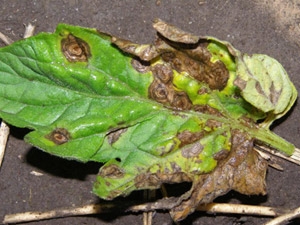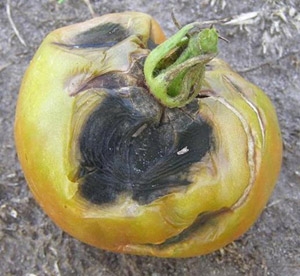Two Tomato Foes: Septoria Leaf Spot and Early Blight
By Nancy Landis, Fairfax Master Gardener
Tomatoes — every gardener’s summer favorite — are as highly favored by plant diseases as they are by humans. One disease that attacks tomatoes during our warm, humid summers is septoria leaf spot. Another is early blight. You will need to be on guard against both in your tomato garden.

Septoria leaf spot on tomato leaves
Septoria leaf spot is caused by the fungus Septoria lycopersici. Also known as septoria blight, this disease can affect tomato plants at any stage of development. The symptoms first appear as small circular spots 1/16 to 1/8 inch in diameter, with a water-soaked appearance. They usually start on the undersides of older, lower leaves about the time the plants are setting fruit. The spots may also be seen on stems and other parts of the plant. Gradually, the spots turn gray to tan in the center, with dark brown margins. As the spots grow larger, they may eventually coalesce. The disease spreads from older, lower leaves to younger ones.
The good news: The disease rarely kills the plant, and spots don’t develop on the actual tomato fruit. The bad news: Diseased leaves drop off early, leaving the fruit susceptible to “scalding” from sun exposure. Septoria does not overwinter in the soil, but spores may overwinter on tomato plant debris that was not removed at the end of the growing season.

Alternaria solani
Septoria leaf spot is found in tomatoes worldwide. This fungus can also affect other plants in the solanaceous, or nightshade, family — eggplant, peppers and tomatoes.
At the same time your tomato plants are affected by septoria leaf spot, they may also have early blight, caused by the fungus Alternaria solani. Alternaria solani, a more serious early blight on tomatoes, affects both leaves and fruit. Early blight is distinguished by larger brown spots on leaves that may enlarge and produce a bulls-eye pattern surrounded by yellow. The spots eventually merge and kill the leaf. In severe cases, early blight also infects stems and fruit.
The best measures for avoiding septoria leaf spot, early blight and other fungal diseases of tomatoes are the same:

Early blight on fruit
- Choose a sunny location, with open space between plants to allow breezes to reach the leaves.
- Increase organic matter in the soil to improve drainage.
- Water at the base of the plants, not from overhead.
- Pick off and discard diseased leaves.
- Don’t handle the plants in wet weather.
- Use stakes or cages to grow your plants vertically, keeping leaves and fruit off the soil.
- Use mulch to isolate the plants from fungal spores lurking in the soil.
- At the end of the season, remove and discard all tomato debris. Do not compost it.
- If possible, rotate the location of your tomato plants at least every three years.
You can also look for hybrid plants grown to have resistance to septoria leaf spot. The labels of these have the letter S (some references list it as the letter L, so be sure to check the vendor’s code definitions) after the name of the tomato variety. According to a publication of the Clemson Cooperative Extension, Tomato Diseases and Disorders, two cultivars — Jasper hybrid, a cherry tomato, and Iron Lady hybrid — exhibit resistance to septoria leaf spot.
Clemson lists 17 cultivars, including Jasper and Iron Lady, that are resistant to early blight. Some seed vendors use the letter code EB to designate early blight resistance; others use AB.
Keep in mind that resistance does not mean immunity. Our experience at Fairfax Gardening with four of the resistant cultivars listed by Clemson indicates that they will still get early blight and septoria, particularly if nonresistant varieties are growing nearby. However, the infections will be less severe.
It’s best to avoid using chemical fungicides on your vegetable garden. If you do want to use a fungicide, check the Virginia Pest Management Guide, Table 2-4.
References
Septoria Leaf Spot of Tomato, Connecticut Agricultural Experiment Station
Septoria Leaf Spot of Tomato, New York State Cooperative Extension, Cornell University, Fact Sheet 735.80
Tomatoes, VCE Publication 426-418
Septoria Leaf Spot in Tomatoes, West Virginia University Extension Service
Tomato Diseases and Disorders, Clemson Cooperative Extension Home and Garden Information Center, HGIC 2217